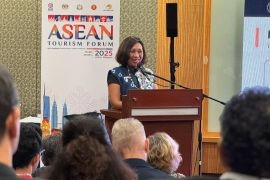The report, which was based on the World Economic Forum`s Travel and Tourism Competitiveness Index (TTCI), ranks Singapore in first place among ASEAN member countries in terms of development of its tourism sector.
Further, according to the report, Singapore draws 20 times more tourists per capita and 30 times more revenues per capita than the ASEAN average. Malaysia is one of the world`s top 10 destinations, with about 25 million visitors per year, while the Philippines - despite being much larger - attracts one-sixth of this number.
The report highlights the enormous potential for developing the Travel & Tourism sector in ASEAN. The region is rich in natural and cultural heritage, and has a long tradition of tourism. It is also strategically located in the heart of Asia. The extraordinary diversity of ASEAN countries further enhances the region`s attractiveness. In addition, the ASEAN region is an affordable destination by international standards.
However, most countries have only partially tapped this potential due to a number of weaknesses. These include inadequate infrastructure, poor public health and weak environmental stewardship. Conservation efforts must protect the region`s extraordinary natural heritage, which is central to its Travel & Tourism competitiveness. In addition, the analysis highlights the significant benefits of Travel & Tourism for the economy and society at large.
"What is good for the travel and tourism sector is good for the economy, and vice-versa. Beyond cultural and natural heritage, the underlying drivers of Travel & Tourism development are often the same as those of other sectors. Think of quality infrastructure, the ease of setting up a business, the absence of crime, and the availability of a healthy workforce," explained Thierry Geiger, economist and lead author of the study.
Meanwhile, Marcio Favilla Lucca de Paula, Executive Director for Competitiveness, External Relations and Partnership Affairs from the World Tourism Organization (UNWTO), stated that ASEAN has a combination of factors that can boost its tourism sector, including a large population, dynamic economies and connectivity advantages, such as budget airlines.
"The region currently accounts for about 10 percent of global travel and tourism. That proportion is forecast to rise to 30 percent in 10 to 20 years.
Additionally, Indonesian Tourism and Creative Economy Minister Mari Elka Pangestu said the tourism sector contributes nine percent of Indonesia`s GDP, with one out of 10 jobs created in the country being tourism-related.
"Tourism has multiplier effects for Indonesia`s economy, spanning from the vegetable sellers in the community to the architects who design hotels and other facilities," she added.
Executive Chairman of the United Arab Emirates` Jumeirah Group, Gerald Lawless, stated tourism is a force for good. Beyond job creation and driving economic growth, the tourism industry makes the local population more aware of their culture and proud of it.
However, despite the potential that can be gained from the tourism sector, ASEAN members were warned about the risk of the rapid development of tourism.
"ASEAN countries must be aware of the negative impacts of the growing tourism sector in the region. Child abuse and social degradation in the destination countries are some of the risks that may occur if the government does not conduct tight regulation on the flow of tourists to the region," Executive Director at Cambodia-based NGO Friends International, Sebastien Marot, said.
He gave an example of an orphanage tourist attraction which is popular among tourists coming to Cambodia. The orphanage attraction in Cambodia, which is usually administered by local people, encouraged tourists to come to certain orphanages to see the children performing traditional dance or other attractions, with the hope that visitors donate to the orphanage.
"The problem is that such attractions can cause more damage than benefits to the children. Loose supervision at the orphanage may cause risks to the children, such as child abuse conducted by irresponsible people," he said.
Marot emphasized the need for ASEAN to develop its tourism sectors, but also ensure that such development does not harm the local people and culture.
Responding to Marot`s view, Indonesian Minister of Tourism and Creative Economy Mari Elka Pangestu said the government`s engagement with local communities around tourist attractions is one of the keys to prevent the negative sides of tourism development in the region.
"People, particularly children, must be aware of the risks at tourist sites, but should also be educated about the positive contributions and how they and their families can benefit from them. In Indonesia, neighborhood watches are being organized to track and report undesirable visitors. On the other hand, tourists should be educated on how to behave and what to expect when getting in touch with foreign cultures," she explained.
(*)
Reporter: Amie Fenia Arimbi
Editor: Aditia Maruli Radja
Copyright © ANTARA 2012











